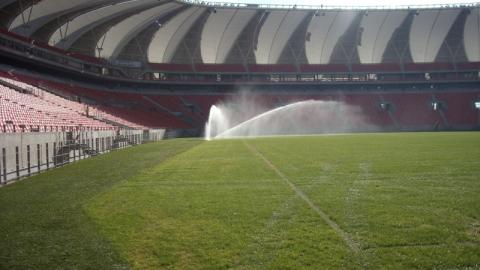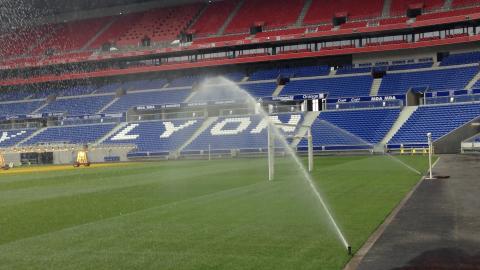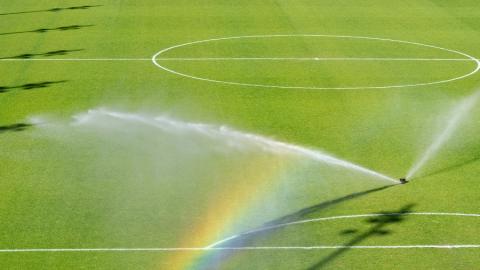Situated at the heart of Toulouse, at ten minutes from the place du Capitole. the Stadium occupies a prime location on the Île du Ramier. Built in 1937 and then renovated on two occasions, for the 1998 World Cup and for EURO 2016, the Stadium has seen a number of necessary modifications over the years, enabling it to host national and international events. It will be one of the venues for the Rugby World Cup next year. Since 2015 and in various stages, the turf and irrigation systems have been entirely modernised on the different pitches in the stadium, using a very high level of technology.

A venue for football tournaments and rugby matches, the Toulouse stadium, also nicknamed the Little Wembley, is considered to be one of the finest and largest stadiums in the whole of the Oc region. The stadium is home to TFC’s football matches and also hosts Toulouse’s rugby matches.
Since 1937, Toulouse Football Club has made the stadium its own. All of the club’s players, technicians and administrators are gathered together at this iconic location. The training pitches of the Technical Centre and the Training Site, which adjoin the stadium, form an architectural complex that allows all the different sectors of the club to work together in harmony.
More than 1,000 matches have been played in the Stadium by the Violets. And some of these have achieved legendary status among the supporters. The mythical TFC/Naples match in the European Cup, in 1986, which saw Philippe Bergeroo and his team mates eliminate the World Champion Diego Maradona. Or even the historic TFC/Liverpool match played by Johan Elmander, Achille Emana & Co, in 2007, in a qualifying round of the Champions League!
A stadium in the process of being completely modernised
I arrived at the stadium on a cold grey morning in early-April, and was met by David Reynard and Céline Prigent, specifications manager at Rain Bird for the south-west and south-east of France respectively.
We were received in the stadium offices by Stephane Cazabat, who is in charge of the stadium’s playing surfaces and green spaces.
“The Toulouse stadium, where some of the renovation work was completed during the 2015-2016 season, was given a new look for the purpose of being part of the organisation of EURO 2016 and thus be able to meet the standards set by UEFA”, explained Mr. Cazabat.
The main pitch was entirely renovated in 2015-2016. After the work was finished, the pink City hosted four matches of this continental competition, including a famous quarter-final (Belgium-Hungary 4:0). New seats were thus installed and the stands improved to provide better spectator comfort. The green rectangle itself had received some outlay before being equipped with state-of-the-art technology in the form of a hybrid turf known as “AirFibr”, a hybrid surface made up of natural and synthetic fibres, easy to maintain and very resistant. The irrigation system was completely redesigned.
The work resumed in 2019, with the complete reconstruction of the playing area: two training grounds reserved for the professionals have been created with the use of the AirFibre technology. One of these has been completed since July 2021 and the other is still under construction and will be ready on 1st July 2022. The latter, located in front of a 300-seat stand, will also be used as a football pitch for matches held at the training centre and for the women’s team. For these two pitches, the turf and the irrigation installations have been created from scratch.
Finally, we saw the young players in training on the one (and a half) pitches laid on a sand soil base. Formerly the first team’s playing field, the training centre has reclaimed it as a Ligue 2 training ground. As far as this pitch is concerned, only the irrigation system has been modified: two irrigation booms have been replaced. It has been operational since 2021. The stadium also has synthetic turf pitches, which are not irrigated.
The main pitch: a customised irrigation system and maintenance programme
We headed towards the main football ground, and entered into a place of breath-taking beauty.
Stéphane Cazabat explained to us what the actual work involved. An AirFibr hybrid turf was installed on drainage layers. This technology consists of a totally natural turf, embedded in a patented synthetic substrate made up of cork granules, synthetic microfibers and extra fine silica sand. The sand is the main component of the substrate. The synthetic microfibers strengthen the turf’s rooting zone. The cork granules absorb the energy of the shock and reduce injuries to players. These surfaces can also be sown with grass seeds or laid with rolled turf. In this case, we have used grass seed.
AirFibr is the 1st product to use enhanced sports turf, designed for player safety and a high level of performance. “AirFibre enhances the energy that the players exert on the pitch”, explained Stéphane Cazabat.
The irrigation system has been replaced completely. 48 Rain Bird 8005 sprinklers have been laid out lengthwise (rows of 3 with separate sprinklers around the edges). “Previously, we had the sprinklers laid out widthwise, but the last sprinkler was irrigating in the shade”, explained Stéphane Cazabat.
The sprinklers in the middle of the pitch are buried 1 centimetre below the soil surface (they are sunk completely into the turf), which means that the players avoid hitting a sprinkler and injuring themselves. These sprinklers are approved by the FFF.
The installation is divided into 12 sections (12 solenoid valves) and it is controlled by a Rain Bird EXP-LXD controller. The stadium’s four irrigated pitches all have their own controller and the whole assembly is connected to a Rain Bird IQ central control unit. Mr. Cazabat is able to manage the irrigation cycles from his mobile phone.
He continues “even at weekends when irrigation is disconnected, I can adjust the irrigation from my home without having to travel to the field. This has been a crucial factor because, when there is a change in the weather, decisions have to be taken very quickly.”
“Managing the irrigation and fertigation of the main pitch is customised to match the plants’ requirements as closely as possible,” explained Mr. Cazabat. “It is almost like bottle-feeding”.
Leaf samples are taken every month and sent to a laboratory for analysis. The laboratory notifies whether there is too little or too much fertiliser. The amount of inputs applied is adjusted according to these analyses and preventive treatments are applied during the summer to pre-empt any diseases.
As far as the water requirements are concerned, a groundsman establishes 30 measuring points with a moisture sensor and measures the soil moisture content. The wilting point for the turf is 30%. Below this, the turf is in water deficit.
“Thus the different parts of the stadium do not all receive the same amounts of water. This is bespoke irrigation, which is extremely precise and applied on a daily basis”, explained Mr. Cazabat.
And he continued, “on match days the irrigation is even more specific and can be switched on at the request of the players. For example, TCF ‘s goalkeeper likes to have plenty of water in front of his goal”.
As a result of this new installation and this daily control of the inputs, the stadium has reduced fertiliser consumption by 50% and halved the water bill. Mr. Cazabat continued: « the soil drains well but it also retains the moisture ».
Eight people work at the site full time. The city of Toulouse owns all the installations and all the people who work at the stadium are municipal employees.
Apart from the irrigation and fertigation there are other maintenance operations carried out at the stadium: aeration and light therapy, restoring the condition of the surface after matches, mowing, changing from a football pitch to a rugby pitch and vice versa.
Every year the surface is stripped bare. “We remove all the plant cover and reseed.” explained Stephane Cazabat. They have the necessary machinery and the stadium’s staff members carry out the work allowing for significant savings to be made on cost.
The playing area is irrigated with the water from the Garonne
The playing area has two brand-new training pitches for the professional players, also using the Air Fibr technique. These pitches have 128 sprinklers Rain Bird (principally 8500 nozzles) and two ESP LXME controllers linked to a Rain Bird IQ4 central control system.
The two pitches a next to each other and are situated close to the Garonne.
The water is pumped from the river bed of the Garonne. It is clean and does not need to be filtered. “A dosing pump was installed but it is not in use”, stated Mr. Cazabat.
The water is stored in a 100m3 underground tank. When irrigation starts, the controller activates the pump in the tank. And when the water level in the tank drops to 30%, it is refilled automatically.
“The main pitch and the sand soil pitch are irrigated with water from the mains (municipal supply) because they are too far from the Garonne”, complains Mr. Cazabat. “It would be possible to connect them to the river system but it would require a lot of work”.
Finally, the stadium’s green spaces (3 hectares) are also irrigated with misters. Mr. Cazabat envisages eventually installing RWS systems (Rain Bird roots water system) for irrigating the trees and linking everything to the central control unit.



